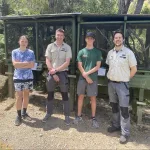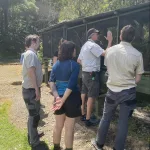Driving Creek is home to the threatened Coromandel Striped gecko also known as the Northern striped gecko.
The species is threatened and nationally vulnerable. For a while, northern striped geckos were so rarely encountered they were considered to be the 'rarest geckos in the world.' More recent survey efforts have confirmed they are on the northern Coromandel Peninsula and can be locally abundant at sites with good pest control. (NZ Herpetological Society).
Early in 2023, a Driving Creek Conservation Team member discovered a Coromandel Striped gecko just outside of the Driving Creek boundary. This prompted a visit from the Auckland Zoo herpetological team to survey the habitat of this rare native species. Luke from the Driving Creek Conservation team guided the Auckland Zoo team through a tour of the property and discussed the conservation efforts of the team. Luke also was able to show the Zoo team where he first spotted the Coromandel Striped Gecko. The group discussed habitats and survey methodologies while viewing the Driving Creek Gecko enclosures.
The Coromandel striped geckos have slender bodies and can grow up to 95 mm in size (from snout to vent) plus their tails which are longer than their body length. The geckos have tan stripes covering their length and may have fine flecks of spots. Male striped geckos have three large pointed scales on each side of the tail base that differentiate them from the females. The geckos have brown or grey eyes and have a distinctive mouth with a pink lining and orange-coloured corners. The striped gecko is similar to the Pacific gecko and goldstripe gecko however, the orange in the corners of the mouth differentiates them. (“Toropuku Inexpectatus | NZHS”)
The striped geckos are arboreal meaning they live in trees and are nocturnal- active at night. They are found inhabiting coastal forests and shrubland. In the Coromandel, they have been seen sun basking on branches and tree trunks, often with their limbs parallel to their bodies. Captive Coromandel striped geckos have been observed leaping with force and speed as a form of escape technique rather than dropping like other native geckos. (“Toropuku Inexpectatus | NZHS”)



References:
- “Toropuku Inexpectatus | NZHS.” www.reptiles.org.nz, www.reptiles.org.nz/herpetofauna/native/toropuku-inexpectatus. Accessed 12 Mar. 2024.
- Driving Creek Conservation Park Update and Work Plan 2024/2025
